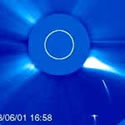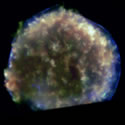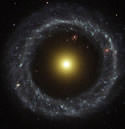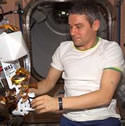Russian space officials sent a letter to their partners today, announcing that astronaut candidate, and ‘N Sync member, Lance Bass was kicked off October’s Soyuz mission to the International Space Station. Apparently the sponsors for the trip were unable to raise the $20 million required to finance the mission, so the Russians finally pulled the plug. Of course, the trip promoters are optimistic; if they can find a sponsor for the trip, and convince Russian officials that Bass can still sneak on board then maybe, just maybe, the 23 year old singer will get his shot into space. (MSNBC story)
Don’t Worry, Everything’s Fine
I apologize for the extensive delays in the last month. I’ve had a series of problems conspire together to keep me from being able to maintain Universe Today: a busted computer, a move to a new house, more work, no Internet, and the attentions of a 10 month old daughter. I think we’re through the worst of it. Thanks for all your support. 🙂
Fraser Cain
Publisher
Comets May Break up More Often than Thought

Image credit: SOHO
Researchers with NASA’s Jet Propulsion Laboratory believe that comets may break up several times before being consumed by the Sun, often taking several orbits to fully come apart. The team analyzed photographs of the region around the Sun and found that comets passed by in clusters or in parallel paths. The pieces are so small that should have disintegrated had they passed the Sun on an earlier trip. This means that the parent comet must have broken up after it passed the Sun.
Some comets may break apart over and over again in the farthest reaches of the solar system, challenging a theory that comets break up only occasionally and not too far from the Sun, says a researcher from NASA’s Jet Propulsion Laboratory, Pasadena, Calif.
A system of comets called “sungrazers,” named for their orbit that closely brushes the Sun, reveals important clues about how these bodies break up. Most sungrazing comets are tiny — the smallest could be less than 10 meters (30 feet) across — and move in a highway-like formation of comets that pass near the Sun and disintegrate.
Dr. Zdenek Sekanina, senior research scientist at JPL, reports in the September 10 issue of the Astrophysical Journal that many sungrazer comets arrive at the Sun in clusters and on parallel paths. He emphasizes that such tiny fragments would have disintegrated if they had come so close to the Sun on an earlier trip. Therefore, the parents of these tiny sungrazers must have broken up after their previous encounter with the Sun and continued to break up far from the Sun on their journey through the solar system.
Sekanina’s sungrazer studies challenge an earlier theory that the only place these comets break up is very close to the Sun, as the strong pull of its gravity cracked their loosely piled chunks of dust and ice. The gradual, continuing fragmentation gives birth to all the sungrazers, the most outstanding examples of splitting comets.
“Astronomers never before realized that there could be a fairly orderly pattern in breaking up, so that one comet cascades into large families of smaller comets, and that this process could be an important part of a comet’s natural life cycle,” Sekanina said.
Sungrazers are not the only comets that can break up far from the Sun. Sekanina points to new observations of comet 57P/du Toit-Neujmin-Delporte, whose fragmentation has led to the formation of a similar, though less prominent, highway of tiny comets. All fragments separated from the comet beyond the orbit of Mars.
Images taken by the European Space Agency’s and NASA’s Solar and Heliospheric Observatory have shown the many tiny sungrazing comets. A movie showing two of these comets can be found at: http://sohowww.nascom.nasa.gov/gallery/LASCO/c2_comets.mpg.
Nearly seven years’ worth of images from the solar observatory revealed more than 400 sungrazers in the Sun’s immediate neighborhood. Sekanina estimates that currently there may be as many as 200,000 sungrazer comets the size of the ones the observatory detected.
The Solar and Heliospheric Observatory is a project of international cooperation between the European Space Agency and NASA. The spacecraft is part of the International Solar-Terrestrial Physics program, a global effort to study the interaction of Sun and Earth. The instrument that observed the comets was developed at the U.S. Naval Research Laboratory, Washington, D.C., with collaborators in the United Kingdom, France and Germany. JPL, a division of the California Institute of Technology in Pasadena, manages the Planetary Atmospheres program for NASA’s Office of Space Science, Washington, D.C.
Original Source: NASA News Release
Supernova Remnant Seen Through Chandra

Image credit: Chandra
The Chandra X-Ray Observatory recently captured a fascinating image of the Tycho supernova remnant. The 20 million degree expanding shockwave of gas and dust is visible at the outside edges of the object; the stellar debris inside is 10-million degrees cooler, and only visible in X-rays. The original supernova explosion was seen by Dutch astronomer Tycho Brahe in the Year 1572.
This Chandra image reveals fascinating details of the turbulent debris created by a supernova explosion that was observed by the Danish astronomer Tycho Brahe in the year 1572. The colors show different X-ray energies, with red, green, and blue representing low, medium and high energies, respectively. The image is cut off at the bottom because the southernmost region of the remnant fell outside the field of view of the detector.
A shock wave produced by the expanding debris is outlined by the strikingly sharp blue circular arcs of twenty million degree Celsius gas seen on the outer rim. The stellar debris, which has a temperature of about ten million degrees and is visible only in X-rays, shows up as mottled yellow, green and red fingers of gas.
Tycho’s supernova remnant presents several interesting contrasts with the Cassiopeia A (Cas A) supernova remnant. The debris for Tycho is distributed in clumps rather than knots as in Cas A, and its outer shock wave can be seen in smooth and continuous arcs rather than being fragmented, as in Cas A.
Also, no central point source is detected in Tycho, in contrast to Cas A. The absence of a central point source is consistent with other evidence that Tycho is a Type Ia supernova, which is thought to signal the detonation and destruction of a white dwarf star. Theory predicts that a white dwarf star will explode when infalling matter from a companion star increases the mass of the white dwarf beyond a critical mass limit, known as the Chandrasekhar limit.
Original Source: Chandra News Release
Experts Estimate Asteroid Risk
At a NASA-sponsored conference, a group of experts have estimated that the Earth is struck once every 1,000 years by an asteroid capable of releasing 10-megatons of energy – not a planet killer, but definitely enough to cause a terrible loss of life. NASA and the astronomical community has been systematically searching for all Near Earth Objects larger than 1 km across, and capable of crossing the Earth’s orbit. So far they’ve found 600 out of an estimated 1,000.
Hubble Images an Unusual “Wheel” Galaxy

Image credit: Hubble
The latest photo taken by the Hubble Space Telescope is of a rare type of galaxy, known as Hoag’s Object, where a ring of stars orbit a yellow nucleus. The bluish outer ring is composed of clusters of hot, young stars while the heart is made of mostly older stars. It’s possible that the “gap” in between contains star clusters too faint to see.
A nearly perfect ring of hot, blue stars pinwheels about the yellow nucleus of an unusual galaxy known as Hoag’s Object. This image from NASA’s Hubble Space Telescope captures a face-on view of the galaxy’s ring of stars, revealing more detail than any existing photo of this object. The image may help astronomers unravel clues on how such strange objects form.
The entire galaxy is about 120,000 light-years wide, which is slightly larger than our Milky Way Galaxy. The blue ring, which is dominated by clusters of young, massive stars, contrasts sharply with the yellow nucleus of mostly older stars. What appears to be a “gap” separating the two stellar populations may actually contain some star clusters that are almost too faint to see. Curiously, an object that bears an uncanny resemblance to Hoag’s Object can be seen in the gap at the one o’clock position. The object is probably a background ring galaxy.
Ring-shaped galaxies can form in several different ways. One possible scenario is through a collision with another galaxy. Sometimes the second galaxy speeds through the first, leaving a “splash” of star formation. But in Hoag’s Object there is no sign of the second galaxy, which leads to the suspicion that the blue ring of stars may be the shredded remains of a galaxy that passed nearby. Some astronomers estimate that the encounter occurred about 2 to 3 billion years ago.
This unusual galaxy was discovered in 1950 by astronomer Art Hoag. Hoag thought the smoke-ring-like object resembled a planetary nebula, the glowing remains of a Sun-like star. But he quickly discounted that possibility, suggesting that the mysterious object was most likely a galaxy. Observations in the 1970s confirmed this prediction, though many of the details of Hoag’s galaxy remain a mystery.
The galaxy is 600 million light-years away in the constellation Serpens. The Wide Field and Planetary Camera 2 took this image on July 9, 2001.
Original Source: Hubble News Release
Russians Say Bass is Back in Training
Pop singer Lance Bass is getting closer to getting his chance to fly in space according to an announcement from the Russian Space Agency on Friday. Bass, 23, will fly to Houston around the end of August where he will receive training from NASA. Although he is backed by a consortium of companies for the trip, no part of the $20 million fee has been paid yet – the Russians are expecting at least a deposit by the end of this week. If all goes well, Bass will join a Soyuz crew in October to visit the International Space Station for a week. He would become the youngest person ever to fly in space.
Astronauts Install Debris Shields on the Station

Image credit: NASA
Expedition Five Commander Valery Korzun and Flight Engineer Peggy Whitson spent more than 4 hours in space on Friday, working on improvements to the International Space Station. During this first of two spacewalks scheduled for Expedition Five, the astronauts installed six debris shields to the outside of the Zvezda module – these are designed to stop micrometeorites from damaging the station and crew. Seventeen more shields will be installed in future missions.
Expedition Five Commander Valery Korzun and Flight Engineer Peggy Whitson stepped outside the Pirs Docking Compartment of the International Space Station today and installed debris shields on the Russian Zvezda Service Module in a 4 hour, 25 minute spacewalk.
It was the first of two spacewalks for the Expedition Five crew, the third of Korzun?s career and the first for Whitson. Today?s excursion was the 42nd spacewalk in support of ISS assembly and maintenance and the 17th staged from the station itself. 25 spacewalks at the ISS have originated from visiting space shuttles. While Korzun and Whitson worked outside, Flight Engineer Sergei Treschev tended to station systems and choreographed the spacewalk from inside Zvezda.
After a 1 hour, 43 minute delay to the start of the spacewalk because of a misconfigured valve regulating the operation of the primary oxygen bottles in their Orlan spacesuits, Korzun and Whitson opened the hatch to Pirs at 4:23 a.m. Central time (923 GMT) as the ISS flew over the southern Atlantic Ocean east of the southern coast of South America at an altitude of 230 statute miles. Their first task was to set up tools and unfurl a telescoping crane called the Strela boom from the side of the docking module that is attached to the nadir port of Zvezda.
They pressed ahead to move six micrometeoroid debris shields from a temporary stowage location on the connecting module adapter between the U.S. and Russian segments of the ISS that were delivered in June during the STS-111 mission of the shuttle Endeavour.
One by one, the shields were affixed around Zvezda, designed to provide debris protection for the lifetime of the module. 17 additional shields will be flown to the ISS on future missions to complete the job.
Because of the late start to the spacewalk, Russian flight controllers decided to defer the refurbishment of an experiment on Zvezda called Kromka, designed to collect samples of residue emitted from the module?s jet thrusters. That lower priority task and the swabbing of thruster residue from Zvezda?s hull for analysis will be conducted on a future spacewalk. It was not immediately known whether Korzun and Treschev would perform those tasks next Friday during the second spacewalk of the Expedition.
After retrieving their tools and stowing the Strela crane, Korzun and Whitson returned to Pirs and closed the hatch at 8:48 a.m. Central time (1348 GMT) to wrap up their excursion.
Korzun will venture outside Pirs one week from today with Treschev to install equipment on the exterior of the Russian module which will facilitate the placement of future payloads and the routing of spacewalkers? tethers and to replace Japanese experiments outside Zvezda which measure the effect of atomic oxygen in low Earth orbit on sample materials. Korzun and Treschev will also install two additional amateur radio antennas outside Zvezda to improve contacts with ham radio operators on Earth.
Information on the crew’s activities aboard the space station, future launch dates, as well as station sighting opportunities from anywhere on the Earth, is available on the Internet at:
http://spaceflight.nasa.gov
Details on station science operations can be found on an Internet site administered by the Payload Operations Center at NASA’s Marshall Space Flight Center in Huntsville, Ala., at:
http://www.scipoc.msfc.nasa.gov
The next ISS status report will be issued on Friday, Aug. 23, after the next station spacewalk, or sooner, if events warrant.
Original Source: NASA News Release
Space Rock Sneaks Past the Earth
Amateur astronomers were given a rare treat on Sunday when asteroid 2002 NY40 passed within 530,000 kilometres of the Earth (a little further than the distance from Earth to the Moon). Over the course of a few hours, the 800 metre space rock passed through several constellations in the night sky, visible in binoculars or a small telescope. 2002 NY40 is of minor concern as astronomers believe there is a 1/500,000 chance it could strike the Earth in 2022 – the flyby will give them an opportunity to better calculate its future path.
NASA Loses Comet Chasing Spacecraft
NASA scientists haven’t given up hope in their search for the missing Contour spacecraft, which disappeared shortly after it was supposed to fire its thrusters on Thursday. A telescope captured an image of two separate objects, moving in the direction Contour was supposed to be headed, leading to speculation that the spacecraft broke in two, but this hasn’t been confirmed yet. Had it worked properly, Contour would now be on its way to meet up with two comets to take high resolution photos of their nuclei.
